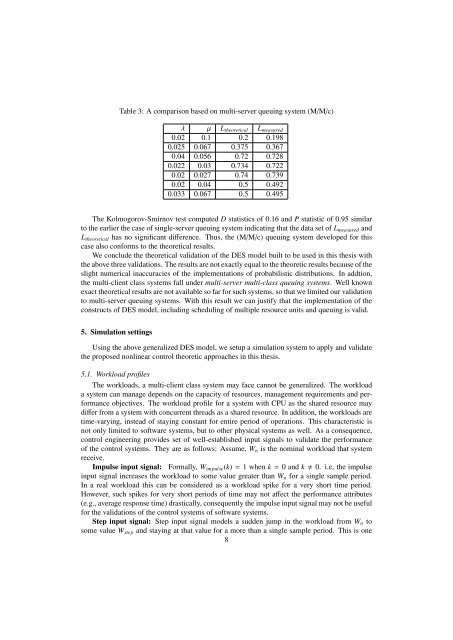A simulation model to implement multiple client class server-client ...
A simulation model to implement multiple client class server-client ...
A simulation model to implement multiple client class server-client ...
Create successful ePaper yourself
Turn your PDF publications into a flip-book with our unique Google optimized e-Paper software.
Table 3: A comparison based on multi-<strong>server</strong> queuing system (M/M/c)<br />
λ µ L theoretical L measured<br />
0.02 0.1 0.2 0.198<br />
0.025 0.067 0.375 0.367<br />
0.04 0.056 0.72 0.728<br />
0.022 0.03 0.734 0.722<br />
0.02 0.027 0.74 0.739<br />
0.02 0.04 0.5 0.492<br />
0.033 0.067 0.5 0.495<br />
The Kolmogorov-Smirnov test computed D statistics of 0.16 and P statistic of 0.95 similar<br />
<strong>to</strong> the earlier the case of single-<strong>server</strong> queuing system indicating that the data set of L measured and<br />
L theoretical has no significant difference. Thus, the (M/M/c) queuing system developed for this<br />
case also conforms <strong>to</strong> the theoretical results.<br />
We conclude the theoretical validation of the DES <strong>model</strong> built <strong>to</strong> be used in this thesis with<br />
the above three validations. The results are not exactly equal <strong>to</strong> the theoretic results because of the<br />
slight numerical inaccuracies of the <strong>implement</strong>ations of probabilistic distributions. In addtion,<br />
the multi-<strong>client</strong> <strong>class</strong> systems fall under multi-<strong>server</strong> multi-<strong>class</strong> queuing systems. Well known<br />
exact theoretical results are not available so far for such systems, so that we limited our validation<br />
<strong>to</strong> multi-<strong>server</strong> queuing systems. With this result we can justify that the <strong>implement</strong>ation of the<br />
constructs of DES <strong>model</strong>, including scheduling of <strong>multiple</strong> resource units and queuing is valid.<br />
5. Simulation settings<br />
Using the above generalized DES <strong>model</strong>, we setup a <strong>simulation</strong> system <strong>to</strong> apply and validate<br />
the proposed nonlinear control theoretic approaches in this thesis.<br />
5.1. Workload profiles<br />
The workloads, a multi-<strong>client</strong> <strong>class</strong> system may face cannot be generalized. The workload<br />
a system can manage depends on the capacity of resources, management requirements and performance<br />
objectives. The workload profile for a system with CPU as the shared resource may<br />
differ from a system with concurrent threads as a shared resource. In addition, the workloads are<br />
time-varying, instead of staying constant for entire period of operations. This characteristic is<br />
not only limited <strong>to</strong> software systems, but <strong>to</strong> other physical systems as well. As a consequence,<br />
control engineering provides set of well-established input signals <strong>to</strong> validate the performance<br />
of the control systems. They are as follows: Assume, W n is the nominal workload that system<br />
receive.<br />
Impulse input signal: Formally, W impulse (k) = 1 when k = 0 and k 0. i.e, the impulse<br />
input signal increases the workload <strong>to</strong> some value greater than W n for a single sample period.<br />
In a real workload this can be considered as a workload spike for a very short time period.<br />
However, such spikes for very short periods of time may not affect the performance attributes<br />
(e.g., average response time) drastically, consequently the impulse input signal may not be useful<br />
for the validations of the control systems of software systems.<br />
Step input signal: Step input signal <strong>model</strong>s a sudden jump in the workload from W n <strong>to</strong><br />
some value W step and staying at that value for a more than a single sample period. This is one<br />
8
















